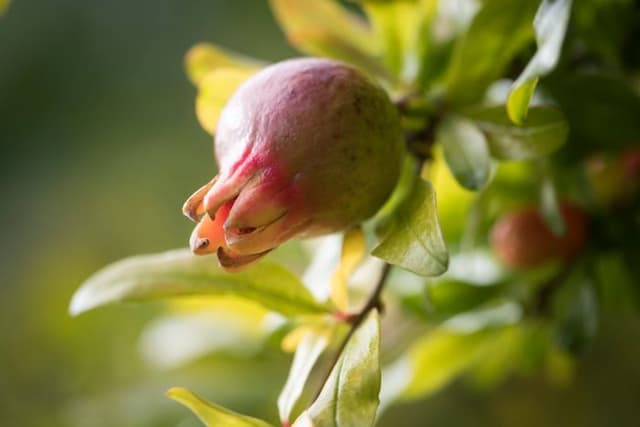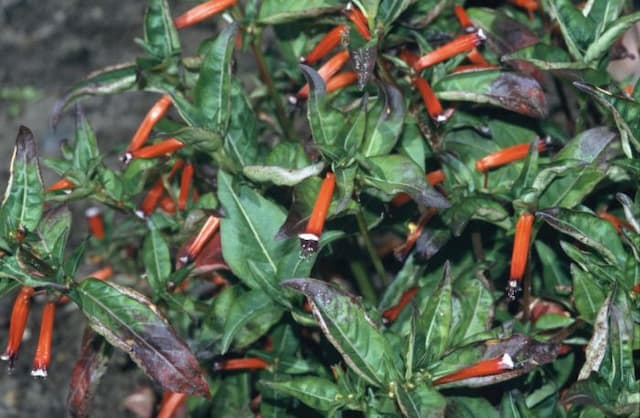Mexican Heather Cuphea hyssopifolia

ABOUT
Cuphea hyssopifolia, commonly known as Mexican heather, is a dense, bushy plant characterized by its small, glossy green leaves that bear a remarkable resemblance to those of the herb hyssop. The leaves are lance-shaped and gently toothed. Throughout the year, this evergreen shrub is adorned with a profusion of small, trumpet-shaped flowers. The blossoms are typically a vibrant purple to lavender in color, although there are varieties that produce white or pink flowers. These petite flowers cluster at the tips of the branches, creating a sprinkling of color that contrasts beautifully with the rich green foliage. The overall shape of the plant is rounded and lush, creating a full appearance. Mexican heather is often used as a ground cover or in borders, where its continuous blooming cycle and attractive foliage add long-lasting beauty to any garden space.
About this plant
 Names
NamesFamily
Lythraceae.
Synonyms
False Heather, Mexican Heather, Hawaiian Heather, Elfin Herb.
Common names
Cuphea hyssopifolia var. hirtella, Parsonsia hirtella.
 Toxicity
ToxicityTo humans
The Mexican Heather, commonly known as Cuphea hyssopifolia, is generally considered to be non-toxic to humans. There are no well-documented cases of poisoning from consuming this plant. Therefore, ingesting parts of the Mexican Heather is unlikely to cause harm or symptoms of toxicity in humans under normal circumstances.
To pets
Cuphea hyssopifolia, commonly known as False Heather or Mexican Heather, is not known to be toxic to pets such as dogs and cats. There is no documented evidence that ingestion of Mexican Heather causes any significant symptoms of poisoning in pets. Thus, it is generally considered safe around household animals, with no serious consequences expected from its ingestion.
 Characteristics
CharacteristicsLife cycle
Perennials
Foliage type
Evergreen
Color of leaves
Green
Flower color
Pink
Height
2 feet [60 cm]
Spread
3 feet [91 cm]
Plant type
Shrub
Hardiness zones
9
Native area
Mexico
Benefits
 General Benefits
General Benefits- Low Maintenance: Mexican Heather is known for being easy to care for, requiring minimal attention once established in a garden.
- Drought Tolerance: It has good resistance to dry conditions, needing only occasional watering, which makes it a good choice for xeriscaping.
- Aesthetic Appeal: With small lavender, purple, or white flowers and fine green foliage, it adds texture and color to garden beds and landscapes.
- Attracts Pollinators: The flowers provide nectar for bees, butterflies, and other pollinators, promoting biodiversity.
- Growth Habit: Its compact and mounding growth habit makes it suitable for borders, edgings, and groundcover.
- Long Blooming Season: Mexican Heather blooms profusely for an extended period, usually from early summer until the first frost.
- Heat Tolerance: It can withstand high temperatures, making it an excellent choice for hot and sunny locations.
- Versatility: This plant can be used in containers, hanging baskets, or as an annual in cooler climates.
 Medical Properties
Medical PropertiesThis plant is not used for medical purposes.
 Air-purifying Qualities
Air-purifying QualitiesThis plant is not specifically known for air purifying qualities.
 Other Uses
Other Uses- Miniature Hedges: Cuphea hyssopifolia can be trimmed and cultivated as miniature hedges for fairy gardens or small-scale landscaping projects due to its dense and compact growth habit.
- Dollhouse Gardening: Its small size and delicate flowers make Cuphea hyssopifolia a suitable choice for dollhouse gardens, adding a touch of realism to miniature scenes.
- Crafting: Dried Cuphea hyssopifolia flowers can be used for crafting, such as making potpourri or incorporating them into homemade bookmarks and greeting cards.
- Education: This plant can serve as an educational tool for teaching children about the lifecycle of plants, from seed to flower, because it is easy to grow and care for.
- Livestock Forage: In some regions, Cuphea hyssopifolia may be used as forage for small livestock, although this is not a common use and suitable only where more typical forage plants are not available.
- Photography: The vibrant flowers of Cuphea hyssopifolia make it a popular subject for photography, helping photographers practice macro and close-up shots.
- Artistic Inspiration: Artists may use Cuphea hyssopifolia as a model for botanical illustration or as part of still life compositions due to its unique form and color.
- Floral Arrangements: Its small yet attractive blooms can be used as filler in floral arrangements to provide texture and a splash of color.
- Theme Gardens: Cuphea hyssopifolia can be planted in "alphabet" or "storybook" theme gardens where each plant represents a letter or a character.
- Butterfly Gardens: Although not unusual, it is notable that Cuphea hyssopifolia is a butterfly attractant and thus is used to establish butterfly gardens to support pollinator populations.
Interesting Facts
 Feng Shui
Feng ShuiThe Mexican Heather is not used in Feng Shui practice.
 Zodiac Sign Compitability
Zodiac Sign CompitabilityThe Mexican Heather is not used in astrology practice.
 Plant Symbolism
Plant Symbolism- Delicateness: With its small leaves and petite structure, Mexican Heather often represents delicate beauty and a gentle spirit.
- Innocence: The unassuming nature of Mexican Heather can signify innocence and a pure heart.
- Youth: The plant's small, fresh flowers and constant blooming can symbolize youthfulness and renewal.
- Harmony: Mexican Heather is a popular choice in gardens for its ability to balance out other plants, representing harmony and balance in life.
- Determination: Despite its delicate appearance, Mexican Heather is quite hardy, and it can symbolize the idea of enduring and overcoming difficulties.
 Water
WaterThe False Heather or Mexican Heather should be watered regularly, keeping the soil consistently moist but not waterlogged. It's best to use about 1 gallon of water every week, but this may vary depending on climate conditions and the size of your plant. During the hotter seasons, increase the frequency of watering, ensuring that the top inch of soil is dry before watering again. Avoid letting the plant sit in water, as this can lead to root rot.
 Light
LightFor the best growth, position your False Heather in a location where it receives full sun to partial shade. It thrives with at least 6 hours of sunlight a day, but in extremely hot climates, some afternoon shade can help protect the plant from scorching. Avoid deep shade, as this will reduce the plant’s flowering potential.
 Temperature
TemperatureThe ideal temperature range for False Heather is between 60 and 85 degrees Fahrenheit. It can tolerate a minimum temperature down to about 30 degrees Fahrenheit for short periods. Avoid exposing the plant to temperatures below this range, as frost can damage or kill it.
 Pruning
PruningFalse Heather benefits from occasional pruning to maintain its shape and encourage bushier growth. Prune lightly after the plant has finished a flush of blooming, usually two to three times per year. The best time for major pruning is in late winter or early spring before new growth begins.
 Cleaning
CleaningAs needed
 Soil
SoilThe Mexican Heather requires well-draining soil rich in organic matter. A mix of peat, pine bark, and perlite in equal parts is ideal. Maintain soil pH between 6 and 7 for optimal growth.
 Repotting
RepottingMexican Heather should be repotted every 2-3 years or when it has outgrown its current pot, to provide fresh soil and encourage continued growth.
 Humidity & Misting
Humidity & MistingMexican Heather thrives best in moderate to high humidity levels, ideally between 50-70%. Avoid placing it in overly dry environments.
 Suitable locations
Suitable locationsIndoor
Place in bright, indirect light and water when the topsoil dries.
Outdoor
Plant in partial shade, protect from harsh sun, and ensure soil drainage.
Hardiness zone
9-11 USDA
 Life cycle
Life cycleCuphea hyssopifolia, commonly known as Mexican Heather, starts its life cycle as a seed that germinates in moist, well-drained soil where it forms a small sprout. As the plant grows, it develops a dense, bushy form with small, lance-shaped green leaves, reaching maturity in a few months under ideal conditions. Throughout spring to fall, it produces a profusion of small, flower buds that blossom into delicate, purple, lavender, or white flowers, attracting pollinators to the garden. After pollination, the flowers may produce tiny seed capsules that, when mature, release seeds for the next generation. In perennial growing zones, the plant enters a period of dormancy in winter, with growth slowing down or ceasing until conditions become favorable again in spring. In areas where it is grown as an annual, the life cycle concludes at the end of the growing season, and new plants must be started from seeds or cuttings the following year.
 Propogation
PropogationPropogation time
Spring to Summer
The most popular method for propagating false heather, a common name for Cuphea hyssopifolia, is through stem cuttings. To propagate, select a healthy, non-flowering stem and cut a piece about 4 to 6 inches (10 to 15 centimeters) long. Remove the lower leaves to expose a few nodes, which is where root growth will be initiated. Dip the cut end in rooting hormone to encourage root development. Plant the cutting in a pot filled with a well-draining potting mix, ensuring that at least a couple of nodes are buried in the soil. Water the cutting and place it in a warm location with indirect light. Keep the soil moist but not waterlogged, and roots should establish in a few weeks, after which it can be transplanted to its final location.



